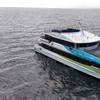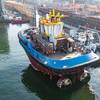Interview: Volvo Penta’s ‘Full Charge’ into Electric & Hybrid
Voices: Ron Huibers, President and CEO, Volvo Penta of the Americas
Volvo Penta has a reputation for pioneering innovations in marine propulsion. To learn more about what the company has on its drawing boards we talked with Ron Huibers, president and CEO of Volvo Penta of the Americas.
Please give us a snapshot of your commercial marine business in North America?
Our marine commercial business in the Americas has seen great growth, and it now represents a significant portion of our business, along with our leisure marine and industrial engine segments. We have a broad offering of commercial-grade diesel engines, including traditional shaft drives, sterndrives, water jets and – of course – our own IPS steerable pods. We are doing very well in high-speed patrol boats and pilot boats, especially with IPS. Field data shows that IPS provides 20 percent faster speed, 30 percent lower fuel consumption and 15 percent faster acceleration when compared to a traditional inboard shaft drive. It also reduces noise and vibration levels on board up to 50 percent. The new Gladding Hearn 55-ft. pilot delivered this year to the Virginia Pilot Association is a good example. The vessel is powered by twin 13-liter 700 hp EPA Tier 3 engines with IPS30 pods, integrated with our EVC electronic steering and control system, including joystick. We are also seeing a growing number of repowers with our EPA Tier 3 diesels, including inland and coastal towing vessels, as well as commercial fishing vessels. In Europe we’re broadening our range of IMO Stage III compliant engines to meet pending emission regulations. We also see a major growth market opportunity for support vessels as the U.S. offshore wind farm industry starts to ramp up.
What lies in the near-term future for Volvo Penta and the marine diesel industry.
For our segment of the commercial marine market we envision the future as a “three-legged stool:” Connectivity, Automation and Electromobility.
Let’s start with connectivity?
The Internet of Things (IoT) revolution is in full swing, but the marine industry has lagged behind terrestrial markets in IoT largely because of the greater difficulty and expense of data connections on the water. But the next generation of very small lightweight, low-Earth-orbit satellites – numbering in the hundreds, or even thousands – will deliver fast, reliable and ubiquitous high-bandwidth data links across the entire globe. We foresee a not-too-distant future when all on-board systems, including the engines, will be fully connected, even far from shore, giving shoreside operators real-time 100% visibility into onboard systems.
And automation?
As you know, the maritime media are full of stories about robotic ships, and there is a great deal of R&D going into this area. Indeed, the first unmanned commercial ferry is already under construction in Norway. Still, the technological and regulatory barriers are formidable, and unmanned ships are probably still a long way off. But there is plenty of room for developing more automated systems that may reduce manning requirements and optimize efficiency in marine operations. To that end, we expect to see more integrated on-board systems that will automate many functions. We will see more integration of systems and increasing levels of automation in the pilot house, in the engine room and throughout the vessel. At Volvo Penta, our strategy is to deliver a complete helm-to-prop solution tied together in an electronic control platform. This summer we demonstrated self-docking technology for a large motor yacht. This technology can easily scale up to commercial vessels.
Now for your third leg – electromobility.
We are 100% committed to electromobility. This summer Volvo Penta issued a statement of intent to go “full charge” into hybrid and electric propulsion with products on the market in 2021. This summer, Volvo Penta unveiled a concept for an IPS hybrid system. It uses technology that was developed within the Volvo Group and which we are adapting and certifying for marine applications. We are initially planning to offer it in our 8-13 liter engine range, focusing on vessels like ferries, pilot boats and offshore supply boats. We are already testing prototypes, and our plan is to have a test boat in sea trials by early 2020 with availability in 2021.
The technical barriers to electromobility are falling fast. Battery technology, in particular, is progressing very rapidly, largely driven by automotive-level R&D programs in the high-volume electric vehicle market. It has been predicted that energy density in lithium ion batteries will increase by 70% over the next two years, while the cost of a lithium ion battery pack will decrease at a similar rate, yielding a lower cost-per-kW hour ratio. And lithium is not the only candidate. There is a great deal of R&D going into alternative energy storage architectures and materials, including graphene balls, protons, supercapacitors and even water-and-salt.
We are making great strides in our electrification journey at Volvo Penta. Over the last several years we have been quietly building competencies and establishing the technologies required to create a sustainable power solutions road map.
















